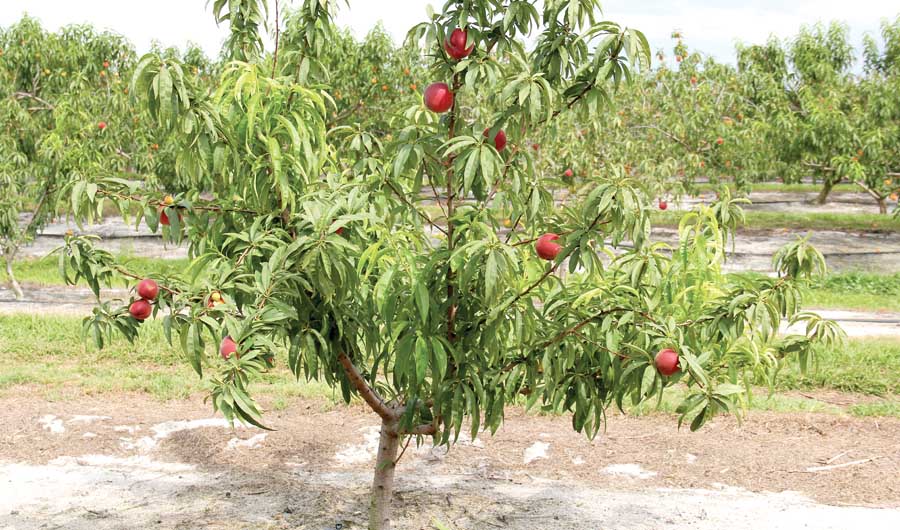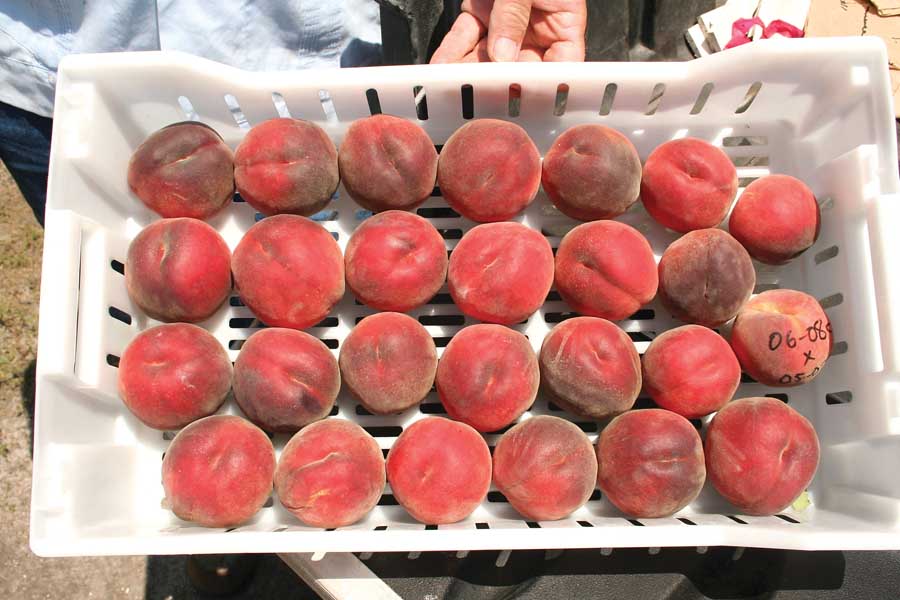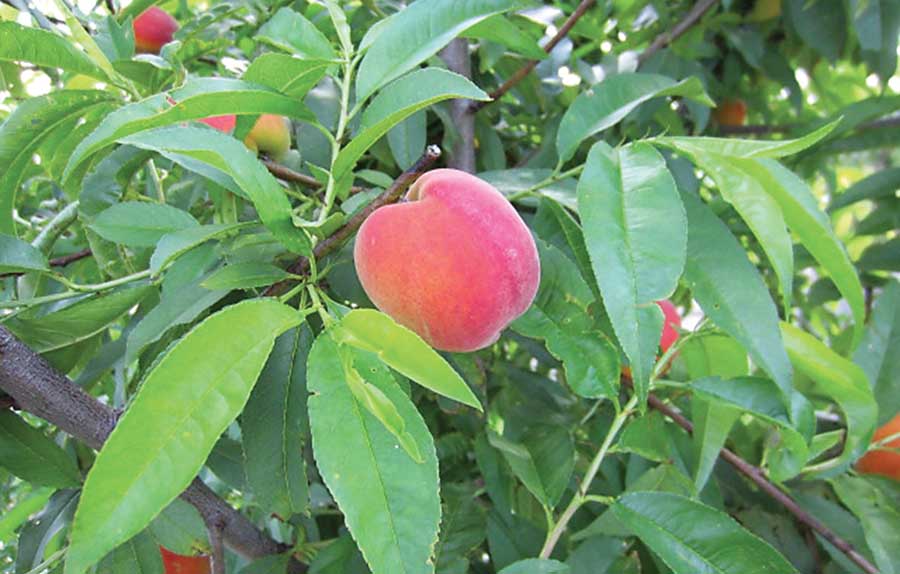
Peaches are nibbling away at citrus acreage in Florida. But with 500,000 acres of citrus and only about 1,500 acres of peaches, it’ll be a long time before peaches rival oranges and grapefruit.
“We will never get there,” says Mercy Olmstead. “Maybe sometime we’ll reach 10,000 acres of peaches.”
Since 2009, Olmstead has been the University of Florida’s extension educator serving about 50 growers who are planting peaches. “There were only about 200 acres in peaches when I started,” she said, “so there’s been quite a bit of growth.”
If Florida reaches 10,000 acres, it will be roughly two-thirds the size of the peach industries in Georgia and South Carolina, each of which has about 15,000 acres.
One reason for the growing interest in peaches in Florida is uncertainty about the future of the citrus industry. In 2005, a new bacterial disease called citrus greening (huanglongbing) was found in south Florida, and it is spreading. It has cost Florida nearly $5 billion in the last decade.
A key problem, Olmstead said, is the researchers have been stymied by not being able to isolate or culture the bacteria, which makes it difficult to do scientific studies.
They know the disease is vectored by the Asian citrus psyllid, which was first found in Florida in 1998. So far, the only control methods are sprays to suppress the psyllid and an intensive scouting program to find and remove infected trees, which serve as a source for continued infection.
Meanwhile, some growers are diversifying into peaches as they remove citrus blocks that have lost enough trees to become unprofitable.
One such grower is James Shinn, who has 1,000 acres of orange groves in the Lake Alfred area in central Florida. “We’re still learning how to make money with peaches. I started planting peaches in 2009,” he said. “I have 85 acres now.
Working with a new crop is a challenge. I had to learn some new tricks. It makes you think.”
Marketing window

One important decision involves choosing a marketing window. In Florida, peaches can reach bloom by Christmas and be ready for market as early as March. From a price standpoint, the earlier, the better, Shinn said.
“You have to thin the daylights out of early peaches to get size,” he said. This means sacrificing yield and running into the possibility of inadequate chill hours for proper bloom.
Left on their own, Florida peaches naturally fit into a marketing window of mid-April to the end of May, but Shinn said most growers would like to be 30 days ahead of that.
Olmstead said the marketing window of opportunity starts to open in March, when imports from Chile begin to taper off.
“Florida peach growers are able to take advantage of a unique marketing window that allows for an increased grower price,” she wrote in a paper. “From late March to May, peach fruit imports are decreasing. While growers in other southeastern states report receiving $0.80 per pound, farm gate prices for Florida growers range from $1.25 to $2 per pound as they are able to produce the first domestic fruit of the calendar year.”
When the Florida growers first started growing peaches, they aimed at putting peaches in an early marketing window in a few cities along the East Coast. Last year, however, Florida peaches were marketed in an estimated 37 to 40 states.
There is evidence that younger people particularly like the firm—some say crunchy—peaches with the non-melting flesh.
Chill hours

Most of Florida’s chill hours are accumulated in December and January. Shinn has been working with Dormex (hydrogen cyanamide), a chemical that is widely used around the world in subtropical areas where chill hours are marginal.
It induces more uniform earlier leaf production (a key to production of large fruit) and flowering, reducing the number of chill hours the tree requires for these processes to take place.
In the central Florida area, the number of chill hours that can be accumulated is about 200, Olmstead said, and thanks to the University of Florida peach breeding program, there are a few varieties that need only 100 to 150 chill hours. Trees that get inadequate chilling have a prolonged bloom and uneven leaf emergence and fruit ripening.
“We get 100 chill hours from Ft. Myers north,” Olmstead said. “We could grow peaches in Miami, but we would have consistency issues.”
Varieties

Florida peaches are not like Georgia or South Carolina peaches. “They have different genetics,” Olmstead said.
They are sweet and juicy, but firm. For many years, peaches with non-melting flesh were used for canning.
“Non-melting flesh peaches didn’t taste as good and the texture was somewhat rubbery,” she said. “They were not very sweet, but in canning the added sugar syrup compensated for that.”
The Florida breeders were able to use the non-melting gene, which makes a peach that can be tree-ripened but stay firm enough to ship well, and combine it with the honey gene for sweetness and other genes for good flavor.
The Florida peaches are also very red.
Shinn said that can make it difficult to harvest. In most peaches, ripeness can be determined by a shift in background color from green to yellow, but there is very little—sometimes no—background color on these peaches.
“We have multiple harvests big time,” Shinn said. If fruit become too mature, shelf life suffers. But if picked less than fully ripe, flavor suffers. “We pick multiple times, every three to six days, picking fruit by size and maturity.”
Growers have mostly settled on four varieties, UFSun, UFGem, Tropic Beauty, and—the latest Florida release—UFBest.
Peaches are like citrus in that they like the well-drained sandy soils of central Florida and don’t like waterlogged conditions. In some areas, growers are using raised beds because hurricanes and heavy rainfall from thunderstorms can create temporary flooding.
Growers are using irrigation as well to supplement rainfall.
Infrastructure
Shinn says it’s taken a lot of work to put together an infrastructure to support the needs of Florida peach growers. A cooperative, Dundee Citrus Growers Association (Dundee CGA), that packs fresh oranges, grapefruit, and tangerines has added a peach packing line and now packs for 26 peach growers, including Shinn.
Pruning is a constant battle in Florida, where growth over the long season can allow trees to get too tall. “We like to hold trees to seven or eight feet, and we don’t want to use ladders,” Shinn said. That means using hedgers to top the trees and pruning in both June and December.
Research
From the start, Florida growers depended heavily on university research leadership, for two big reasons—varieties and rootstocks. When Olmstead came to Florida to head the extension effort, it strengthened the grower support dimension. (Olmstead, in fact, is the extension leader for the national RosBREED fruit breeding project.)
Recently, Olmstead has been trying to get a Florida Peach Growers Association up and running.
And, working with nurseryman Phil Rucks, growers are being asked to consider establishing a statewide marketing order that would raise money to fund marketing and research.
Florida has a unique nematode species that attacks peaches, so the only rootstock that’s available for growers to use is Flordaguard.
“All stone fruit grown in Florida are grafted to rootstock because of the presence of the peach root-knot nematode (Meloidogyne floridensis),” Olmstead wrote in a paper. “Flordaguard is a nematode-resistant rootstock that is currently recommended for both commercial and dooryard production.”
That rootstock was released by the University of Florida in 1991.•






Where can we buy Tropic Beauty or other peach that will grow in Fl?
Lowes and Home Depot carry some of the Florida Peaches that are on the Flordaguard rootstock. I’ve seen peach trees for sale at a place that has the name Tractor in it. These trees are coming from Tennessee and are NOT Florida Peaches. Check with your local larger Florida nurseries to find the variety that corresponds with the expected chill hours for your location in Florida.
If you contact Dr. Mercy Olmstead at the University of Florida she will give you the names of nurseries that can provide them for you.
Thanks, Benjamin!
Good morning. When should I prune my tropical beauty? It would be the 1st time
in the store all i see are “tree-ripened peach” . Im trying to decide which peach tree to buh but don’t want to get one of those with the wrong flavor.
Which is the tangy peach?